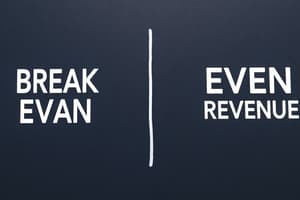Podcast
Questions and Answers
What is the margin of safety?
What is the margin of safety?
- The amount by which sales exceed the break-even point (correct)
- The minimum number of units a business must sell to avoid losses
- The difference between fixed costs and variable costs
- The maximum number of units a business can sell before reaching capacity
If the break-even quantity calculation results in a non-whole number, what should the business do?
If the break-even quantity calculation results in a non-whole number, what should the business do?
- Round down to the nearest whole number
- Recalculate using different cost and price figures
- Use the non-whole number as is
- Round up to the nearest whole number (correct)
Which of the following is NOT a useful application of break-even analysis in business decision-making?
Which of the following is NOT a useful application of break-even analysis in business decision-making?
- Evaluating the feasibility of new products
- Assessing the impact of changes in costs
- Forecasting long-term market trends (correct)
- Determining pricing strategies
If a business wants to increase its margin of safety, which of the following actions would be most effective?
If a business wants to increase its margin of safety, which of the following actions would be most effective?
What is a potential limitation of using break-even analysis for business decision-making?
What is a potential limitation of using break-even analysis for business decision-making?
If a business sells a product for $20 and has variable costs of $12 per unit and fixed costs of $10,000, what is the break-even quantity?
If a business sells a product for $20 and has variable costs of $12 per unit and fixed costs of $10,000, what is the break-even quantity?
What is the definition of the break-even point?
What is the definition of the break-even point?
What information does the break-even point provide to a business?
What information does the break-even point provide to a business?
What is the purpose of a break-even graph?
What is the purpose of a break-even graph?
In the example provided, what is the break-even point for the business selling t-shirts?
In the example provided, what is the break-even point for the business selling t-shirts?
What is the significance of the margin of safety shown in the break-even graph?
What is the significance of the margin of safety shown in the break-even graph?
What is the key relationship between total revenue and total costs at the break-even point?
What is the key relationship between total revenue and total costs at the break-even point?
Flashcards are hidden until you start studying
Study Notes
Break-Even Analysis
- The margin of safety is the amount by which actual sales exceed break-even sales, providing a buffer against losses.
Non-Whole Break-Even Quantity
- If the break-even quantity calculation results in a non-whole number, the business should round up to the nearest whole number to ensure profitability.
Limitations of Break-Even Analysis
- One limitation of break-even analysis is that it assumes a constant selling price and constant variable costs per unit, which may not always be the case.
Increasing Margin of Safety
- To increase its margin of safety, a business can increase its selling price, reduce its variable costs, or reduce its fixed costs.
Break-Even Point Calculation
- The break-even point can be calculated using the formula: Break-Even Quantity = Fixed Costs / (Selling Price - Variable Costs).
- Example: If a business sells a product for $20 and has variable costs of $12 per unit and fixed costs of $10,000, the break-even quantity is 1,000 units.
Break-Even Point Definition
- The break-even point is the level of sales at which a business's total revenue equals its total costs, resulting in neither profit nor loss.
Break-Even Point Information
- The break-even point provides a business with information about the level of sales required to cover its costs and avoid losses.
Break-Even Graph Purpose
- The purpose of a break-even graph is to visually represent the relationship between a business's total revenue and total costs at different levels of sales.
Break-Even Point Example
- In the example of a business selling t-shirts, the break-even point represents the number of t-shirts the business must sell to cover its costs.
Margin of Safety Significance
- The margin of safety shown in the break-even graph represents the amount by which actual sales can fall below break-even sales before the business incurs a loss.
Key Relationship at Break-Even Point
- At the break-even point, the total revenue equals total costs, resulting in a zero profit margin.
Studying That Suits You
Use AI to generate personalized quizzes and flashcards to suit your learning preferences.




